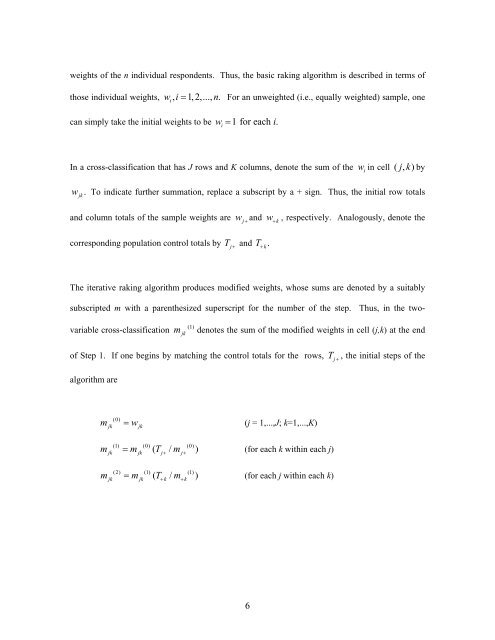Practical Considerations in Raking Survey Data
Practical Considerations in Raking Survey Data
Practical Considerations in Raking Survey Data
Create successful ePaper yourself
Turn your PDF publications into a flip-book with our unique Google optimized e-Paper software.
weights of the n <strong>in</strong>dividual respondents. Thus, the basic rak<strong>in</strong>g algorithm is described <strong>in</strong> terms of<br />
those <strong>in</strong>dividual weights, w, i = 1,2,..., n.<br />
For an unweighted (i.e., equally weighted) sample, one<br />
i<br />
can simply take the <strong>in</strong>itial weights to be w = 1 for each i.<br />
i<br />
In a cross-classification that has J rows and K columns, denote the sum of the<br />
wi<br />
<strong>in</strong> cell ( j, k)<br />
by<br />
w . jk<br />
To <strong>in</strong>dicate further summation, replace a subscript by a + sign. Thus, the <strong>in</strong>itial row totals<br />
and column totals of the sample weights are<br />
w<br />
j +<br />
and<br />
correspond<strong>in</strong>g population control totals by T +<br />
and .<br />
j<br />
T + k<br />
w + k<br />
, respectively. Analogously, denote the<br />
The iterative rak<strong>in</strong>g algorithm produces modified weights, whose sums are denoted by a suitably<br />
subscripted m with a parenthesized superscript for the number of the step. Thus, <strong>in</strong> the twovariable<br />
cross-classification<br />
m (1) jk<br />
denotes the sum of the modified weights <strong>in</strong> cell (j,k) at the end<br />
of Step 1. If one beg<strong>in</strong>s by match<strong>in</strong>g the control totals for the rows,<br />
algorithm are<br />
T<br />
j +<br />
, the <strong>in</strong>itial steps of the<br />
m<br />
(0)<br />
jk<br />
= w<br />
(j = 1,...,J; k=1,...,K)<br />
jk<br />
m = m ( T / m )<br />
(for each k with<strong>in</strong> each j)<br />
(1) (0) (0)<br />
jk jk j+ j+<br />
m = m ( T / m )<br />
(for each j with<strong>in</strong> each k)<br />
(2) (1) (1)<br />
jk jk + k + k<br />
6
















